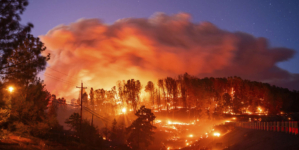-
Rangers vs. Blue Jays Highlights | MLB on FOX - 8 mins ago
-
Harvey Weinstein’s Medical Condition Takes Massive Turn - 28 mins ago
-
Dodgers’ Freddie Freeman scratched, returning to Los Angeles to be with family - 51 mins ago
-
Missing Tanker Plane Fighting Oregon Wildfire Found, Pilot Dead - about 1 hour ago
-
Reds vs. Rays Highlights | MLB on FOX - 2 hours ago
-
F1 News: Red Bull Hit With Unexpected Fines at Belgian Grand Prix - 2 hours ago
-
Interview with Rheinmetall Hungary CEO, Paul Walf - 2 hours ago
-
Athletics vs. Angels Highlights | MLB on FOX - 2 hours ago
-
Harrison Butker’s Comments on Olympics Opening Ceremony Goes Viral - 2 hours ago
-
Rockies vs. Giants Highlights | MLB on FOX - 3 hours ago
Einstein Proven Right on Black Holes’ ‘Plunging Regions’
A prediction originally made by Albert Einstein about a “plunging region” around black holes has finally been confirmed.
Researchers from Oxford University in the United Kingdom discovered that Einstein’s prediction of how gravity works around a black hole does indeed ring true, and that these “plunging regions” have some of the strongest gravity ever seen, according to a new paper in the Monthly Notices of the Royal Astronomical Society.
This was discovered using X-ray data collected from several nearby black holes by NASA’s NuSTAR and NICER telescopes in orbit around the Earth.
Black holes have a gravitational pull so strong that not even light can escape them. The event horizon is the boundary surrounding a black hole beyond which nothing can escape, while deep within the core is a singularity, where matter is crushed to infinite density.
ISTOCK / GETTY IMAGES PLUS
Einstein’s theory of gravity suggested that as an object approaches a black hole, it reaches a certain distance where it cannot orbit in a circle like a planet around a star, and instead, plunges towards the black hole at near the speed of light. The region where this occurs was named the “plunging region”, within which it is impossible to stop the final descent past the black hole’s event horizon.
Until now, this region was not confirmed to exist, but using X-ray data from black holes and how stellar plasma falls into them, astrophysicists have confirmed the “plunging region” theory.
“Einstein’s theory predicted that this final plunge would exist, but this is the first time we have been able to demonstrate it happening. Think of it like a river turning into a waterfall—hitherto, we have been looking at the river. This is our first sight of the waterfall,” study co-author Andrew Mummery, an astrophysicist at the University of Oxford, said in a statement. “This final plunge of plasma happens at the very edge of a black hole and shows matter responding to gravity in its strongest possible form.”
“This is the first look at how plasma, peeled from the outer edge of a star, undergoes its final fall into the center of a black hole, a process happening in a system around 10,000 light years away,” said Mummery. “We believe this represents an exciting new development in the study of black holes, allowing us to investigate this final area around them. Only then can we fully understand the gravitational force.”
Due to their light-gobbling nature, black holes are hard to observe, meaning that scientists must instead watch for the effects of their gravity on nearby objects, such as stars orbiting an invisible mass, or X-rays from the accretion disk of material falling into the black hole. The researchers mainly looked at small black holes closer to Earth in this study, but a second team hopes to secure funding to build a whole new telescope to look at the supermassive black hole in the center of our galaxy, and beyond.
“What is really exciting is that there are many black holes in the galaxy, and we now have a powerful new technique for using them to study the strongest known gravitational fields,” Mummery said.
Do you have a tip on a science story that Newsweek should be covering? Do you have a question about black holes? Let us know via science@newsweek.com.
Uncommon Knowledge
Newsweek is committed to challenging conventional wisdom and finding connections in the search for common ground.
Newsweek is committed to challenging conventional wisdom and finding connections in the search for common ground.
Source link































